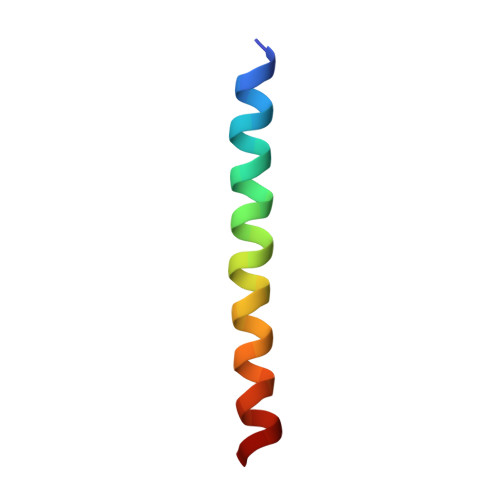Nuclear Magnetic Resonance Structures of GCN4p Are Largely Conserved When Ion Pairs Are Disrupted at Acidic pH but Show a Relaxation of the Coiled Coil Superhelix.
Kaplan, A.R., Brady, M.R., Maciejewski, M.W., Kammerer, R.A., Alexandrescu, A.T.(2017) Biochemistry 56: 1604-1619
- PubMed: 28230348
- DOI: https://doi.org/10.1021/acs.biochem.6b00634
- Primary Citation of Related Structures:
5IEW, 5IIR, 5IIV - PubMed Abstract:
To understand the roles ion pairs play in stabilizing coiled coils, we determined nuclear magnetic resonance structures of GCN4p at three pH values. At pH 6.6, all acidic residues are fully charged; at pH 4.4, they are half-charged, and at pH 1.5, they are protonated and uncharged. The α-helix monomer and coiled coil structures of GCN4p are largely conserved, except for a loosening of the coiled coil quaternary structure with a decrease in pH. Differences going from neutral to acidic pH include (i) an unwinding of the coiled coil superhelix caused by the loss of interchain ion pair contacts, (ii) a small increase in the separation of the monomers in the dimer, (iii) a loosening of the knobs-into-holes packing motifs, and (iv) an increased separation between oppositely charged residues that participate in ion pairs at neutral pH. Chemical shifts (HN, N, C', Cα, and Cβ) of GCN4p display a seven-residue periodicity that is consistent with α-helical structure and is invariant with pH. By contrast, periodicity in hydrogen exchange rates at neutral pH is lost at acidic pH as the exchange mechanism moves into the EX1 regime. On the basis of 1 H- 15 N nuclear Overhauser effect relaxation measurements, the α-helix monomers experience only small increases in picosecond to nanosecond backbone dynamics at acidic pH. By contrast, 13 C rotating frame T 1 relaxation (T 1ρ ) data evince an increase in picosecond to nanosecond side-chain dynamics at lower pH, particularly for residues that stabilize the coiled coil dimerization interface through ion pairs. The results on the structure and dynamics of GCNp4 over a range of pH values help rationalize why a single structure at neutral pH poorly predicts the pH dependence of the unfolding stability of the coiled coil.
Organizational Affiliation:
Department of Molecular and Cell Biology, University of Connecticut , Storrs, Connecticut 06269-3125, United States.














